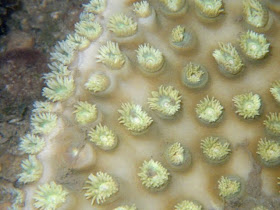
This morning, there were more people than usual as we have with us personnels from URA and NParks to explore this lovely shore with us.
While Ria did the guiding, the rest of us went off for the giant clam search for Mei Lin's project.

The first sight that greeted us on the reefs will be the bleaching of many soft corals. Most of the soft corals are in pale yellow and are in the process of bleaching. Many of them are the Leathery soft corals (Family Alcyoniidae).

While some other are completely bleached in white like the one on the right.

When stressed, corals can produce mucus to shed away sediments or materials that cause the stress. This may also be a response to the coral bleaching. It is sad to see this soft coral "rotting". The only comfort is that such soft corals in this state is not common.

Even the Frilly sea anemones (Phymanthus sp.) were not spared the agony of bleaching. As Marcus shared with us, these anemones that were once difficult to spot are now much easier to find as they are all white and the brighter coloration is easier to spot.

Thankfully, other anemones such as the Haddon's carpet anemones (Stichodactyla haddoni) are still looking normal.
Some hard corals were not spared as well, especially species such as the Cauliflower coral (Pocillopora sp.).

While others are still hanging on. This hard coral that looks decently alright is the Flowery disk coral (Turbinaria sp.).

The uncommon Pebble coral (Astreopora sp.) is also as green as it usually is.

Back to the main task of finding giant clams, I found this rock with shells of two dead Burrowing Giant Clams (Tridacna crocea).

It was great that the adult Fluted giant clam (Tridacna squamosa) that Ria found the other time was sighted again! This time with Mei Lin around, this clam can be recorded for her research!

Chay Hoon found one of my favourite sea stars: the Cushion star (Culcita novaeguinea). This star is quite small and has pretty yellow and black patterns.

I later also found a similar looking cushion star! Cyrene Reef is a wonderful nursery for all these young marine creatures, especially with its lush seagrass meadows.

The find of the day will be this sea star that Chay Hoon found. It looks very similar to that found at Pulau Jong previously. It is around 1cm in length only! We still have no idea what exactly it is!

Here's a closeup of this pretty star. I like the central red blotch on its upper surface.

The only slug that I came across will be this Polka-dot nudibranch (Jorunna funebris).
The trip today was cut short because of the rain that came in from all directions. The sky looked really threatening. As Cyrene Reef is just a patch of flat intertidal land in the sea, it is important to evacuate immediately if there is any signs of lightning.

As we head back to the departure point, I noticed that many of the Knobbly sea stars (Protoreaster nodosus) are crowded at that area! It took me only about 5 mins to take photos of these stars!

Here's another of the knobbly sea star that seems to be saying goodbye to us! Looking forward to coming back Cyrene Reef on a rainless day to have a proper good look.
More photos of the trip here: http://www.flickr.com/photos/koksheng/archives/date-taken/2010/06/16/
No comments:
Post a Comment